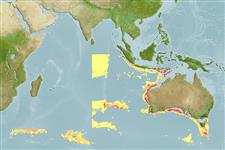Elasmobranchii (tubarões e raias) (sharks and rays) >
Carcharhiniformes (Ground sharks) >
Scyliorhinidae (Cat sharks) > Scyliorhininae
Etymology: Cephaloscyllium: cephalus, from kephale (Gr.), head, referring to its very broad and depressed head; skylion, Greek for dogfish or small shark. (See ETYFish); hiscosellum: hisco (L.), open; sella (L.), saddle, referring to distinctive open-centered saddle-like markings that dominate its color pattern. (See ETYFish).
Environment: milieu / climate zone / depth range / distribution range
Ecologia
marinhas batipelágico; intervalo de profundidade 294 - 420 m (Ref. 76949). Subtropical
Eastern Indian Ocean: Australia.
Comprimento de primeira maturação / Tamanho / Peso / Idade
Maturity: Lm 46.0, range 46 - 46.3 cm
Max length : 46.3 cm TL macho/indeterminado; (Ref. 76949); 52.0 cm TL (female)
Descrição suscinta
Morfologia | Morfometria
A small species with the following characters: head 8.9-13.1% TL in height, trunk width 12.9-19.1% TL; origin of first dorsal-fin usually over mid pelvic-fin base; prenarial length 4.5-5.2% TL; preorbital snout length 1.4-1.6 times prenarial length, 2.6-3.1 in prepectoral length, 5.9-6.7 in prepelvic length; snout-vent length long, 46.2-51.2% TL; nostril 2.5-3.1% TL in width; eye-spiracle space wide, 0.8-1.2% TL; pectoral fin moderate-sized, height 8.7-12.2% TL, posterior margin length 7.4-11.4% TL; anal fin relatively low, height 2.8-3.7% TL; anal-caudal space 5.4-6.5% TL; precaudal length 76.4-79.2% TL; interdorsal space 7.4-9.6% TL; teeth with 3-5 cusps near symphysis of upper jaw; flank denticles are mainly unicuspidate; back without greatly enlarged denticles; long adult clasper, up to 9.3% TL, reaching anal-fin origin; vertebral centra 100-108; low tooth count, each jaw with teeth between 45 and 63; dorsal surface with a striking pattern of dark brown, open-centered saddles (Ref. 76949).
Ciclo de vida ou comportamento de acasalamento
Maturidade | Reprodução | Desova | Ovos | Fecundidade | Larvas
White, W.T. and D.A. Ebert, 2008. Cephaloscyllium hiscosellum sp. nov., a new swell shark (Carcharhiniformes: Scyliorhinidae) from Northwestern Australia. pp. 147-157. In P.R. Last, W.T. White and J.J. Pogonoski (eds). Descriptions of new Australian chondrichthyans. CSIRO Marine and Atmospheric Research Paper no. 22. 365 p. (Ref. 76949)
Status na Lista Vermelha da UICN (Ref. 130435)
Ameaça para os humanos
Harmless
Uso pelos humanos
Mais informação
Idade/TamanhoCrescimentoPeso-comprimentoComprimento-comprimentoFrequências de comprimentoMorfometriaMorfologiaLarvasDinâmica larvalRecrutamentoAbundânciaBRUVS
ReferênciasAquaculturaPerfil para aquaculturaEstirpesGenéticaElectrophoresesHereditariedadeDoençasProcessamentoNutrientsConversão de massa
ColaboradoresFotosStamps, Coins Misc.SonsCiguateraVelocidadeTipo de nataçãoÁrea branquialOtólitosCérebrosVisão
Ferramentas
Relatórios especiais
Baixar XML
Fontes da internet
Estimates based on models
Preferred temperature (Ref.
123201): 7.7 - 12.5, mean 11.8 °C (based on 14 cells).
Índice de diversidade filogenética (Ref.
82804): PD
50 = 0.5000 [Uniqueness, from 0.5 = low to 2.0 = high].
Bayesian length-weight: a=0.00263 (0.00139 - 0.00497), b=3.21 (3.04 - 3.38), in cm total length, based on LWR estimates for this (Sub)family-body shape (Ref.
93245).
Nível Trófico (Ref.
69278): 4.0 ±0.5 se; based on size and trophs of closest relatives
Resiliência (Ref.
120179): Baixo, tempo mínimo de duplicação da população 4,5 - 14 anos (Preliminary low fecundity).
Fishing Vulnerability (Ref.
59153): Moderate vulnerability (41 of 100).
